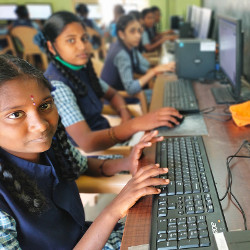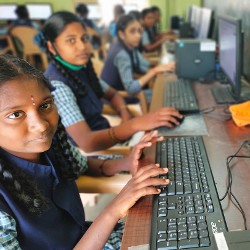
The problem of underrepresentation of women studying STEM subjects is well known and is being faced by several nations across the world. The field of computer science is no exception to this deteriorating gender ratio, nor is the Indian case. The male:female population ratio in India is 1.06, but the ratio of females making it to engineering institutions is lower, at 1.79.1 In absolute numbers, India produces around 1.5 million engineers from its 6,000+ engineering institutions across the country.2 When it comes to employ-ability, 4.03% of male engineering students are employable by IT product firms, while only 2.54% of females are employable by these firms, and 16.67% of males as against 15.49% of females are employable by IT Services organizations. If we shift our focus to the employability of the graduates of top engineering institutions in the country—Indian Institutes of Technology (IITs), National Institutes of Technology (NITs), and other leading engineering educational institutions including International Institutes of Information Technology (IIITs)—employability among fresh graduates in IT product roles increases to 22.67%, and in IT Services roles, it is 36.29%.1
These numbers clearly indicate that the pipeline of engineers possessing skills relevant for current-generation computing jobs is leaky. The problem of underrepresentation of girls in Engineering starts at the higher secondary levels in India, with stream choice at this level shaping subsequent possibilities at the college level. National-level data reveals a gender disparity in school-level stream choice, with girls favoring Humanities over Science and Commerce, leading to gender gaps in undergraduate streams.3 An already-skewed pipeline from high school gets further narrowed through the stringent entry criteria of the IITs. At this stage, women are affected adversely by the need to attend coaching classes towards qualifying in these tests: due to the restrictions imposed on their mobility, women experience this burden differently than men.4 For all of these reasons, as of 2016, only 28% of students studying in various engineering institutions were girls; further, in the IITs, this was a mere 8%.5 We see there aren't enough female engineers graduating from (top) engineering institutions, and so even fewer of them are employable and in a position to ascend the career ladder or pursue research.
The supernumerary system being implemented by the IITs is laudable, especially for its recognition that the problems women in engineering face are structural and the choice to implement a structural solution rather than putting the onus solely on individual women to "lean in" or "work harder."
Why does any of this matter? Even beyond the equity concern, the deteriorating ratio of women pursuing careers in computer science and AI also has (and has already had) a cascading effect on the outputs from the field: research suggests the lack of gender diversity in these industries has shaped gender bias in video game design,6 in algorithms that work on social media platforms7 and those that are used by researchers to analyze data.8 This should not be surprising, given what history tells us about the long-term consequences of skewed gender ratios in law, medicine, and a plethora of other fields.9,10,11,12,13 A recent UNESCO report14 suggests that "To close gender gaps, women require equal opportunity to access the resources, training, and skills they need to thrive in the workplace of tomorrow. That means access to education, reskilling and upskilling for the jobs of the future." Several initiatives have come up to address these gender gaps in the context of engineering education in India recently, some of which we outline here.
The Indian Government has started many initiatives to ensure a healthy male:female ratio in India's top Engineering and Science institutions. The Central Board of Secondary Education in India launched project 'Udaan', through which selected female students are provided with study materials pre-loaded on tablets, and coached remotely to prepare for the Joint Entrance Examination (JEE).a The 'Udaan' project helped 135 girl students clear the JEE Main examinations in the year 2017.15
Another effort to increase the number of women has been through the institution of additional seats for women in engineering colleges. About 30% of girls from the Sciences stream in high school take the JEE (Main) examination, and a subset qualifies for JEE Advanced. A ranking in JEE Advanced is necessary to obtain admission to the IITs. While about 4,000 girls qualified with rankings in JEE Advanced, only 848 of them joined the IITs in the year 2017.5 The leading reasons were a preference for specific branches of study, and restricted geographical mobility imposed by their families. To address this problem and to increase the number of girls in these elite institutions, India's Ministry of Human Resource Development, the ministry responsible for the IITs and NITs, directed these institutions to increase the number of seats available for women and to prepare a separate merit list for girls who qualify through the JEE examination. It was decided to target Bachelor's in Technology (BTech) female enrollment, which was 14% in 2018, 17% in 2019, and 20% in 2020.5,16 To do this, they increased the total number of seats; that is, the increased number of seats for women were 'supernumerary.' For example, if an IIT had 1,000 seats and nominally 80 (8%) females were admitted, the target for the year 2018 was set to 14%. Consequently, 60 female supernumerary seats were added, resulting in 140 seats for female students only. This system does not reduce the number of male students admitted, and rank-based merit is strictly followed within the pools of male and female candidates. The supernumerary system also comes with a time limit within which to achieve a sustained increase in numbers of women admitted.5
This unique model has been very successful in increasing the total intake of girls to the IITs and to the NITs, which followed a similar supernumerary system with ranks based exclusively on JEE Main. A study by the Gender Cell of IIT Delhi indicates that women outperform men in terms of their overall cumulative grade point average (CGPA) in their classes at IIT, even if they come from slightly lower JEE Advanced ranks.17 The fact that India's other top institutions for Science and Technology have adopted this model to increase the intake of female students in the past couple of years is also a testament to the success of this model.
The supernumerary system being implemented by the IITs is laudable, especially for its recognition that the problems women in engineering face are structural, and the choice to implement a structural solution rather than putting the onus solely on individual women to "lean in" or "work harder." The system appears to be yielding results, but we will need to wait and watch how permanent its solutions will prove to be, especially considering its fixed tenure.
But even as this system hopes to partially fix one portion of the leaky pipeline, various other leaks abound along the pipe as outlined earlier, and we must work on these in parallel. The introduction of women into engineering institutions through supernumerary seats or gender diversity pools is just the first step. It needs to be accompanied by the creation of an institutional environment where students who enter through these channels feel safe and can thrive. This might require sensitivity sessions for both faculty and students to explain the rationale for the system, and mentorship programs by alumnae who have been through the system. In some cases, these measures are already in place. The institution should also encourage women who come through supernumerary seats to "accept and take ownership of the ample endowments presented by affirmative action, instead of being bogged down by imposter syndrome."18
More fundamentally, we need to take a hard look at how we frame the issue of gender parity in terms of "merit" today. There is ample research to indicate that whenever we equate exam-taking (or any single metric rather than a holistic evaluation of a candidate) to merit, we risk building a homogenous community, with members of various population groups (including but not restricted to gender) who may underperform on that one metric for a variety of reasons. Studies have directly implicated standardized entrance exams in the skewed gender ratio in top engineering institutions in the past in the U.S., and in India at present.19 Researchers have argued more broadly that the myth of such a meritocracy and the focus on individual talent has only served to make invisible and reproduce structural inequalities in modern-day education, industries, and workplaces in various parts of the globe.10,20,21 We need to revisit the concept of entrance exams as a qualifier for access to quality higher education.
Finally, we might also want to reframe this issue in terms of who it affects. Rather than presenting this as a "women's problem," we as individual teachers and mentors, and as institutions and communities, need to persuade our communities that it is nothing short of the future of computer science, the relevance and novelty of the computing technologies we design and who we design for, that are at stake. Without women in dominant positions as designers, teachers, and experts of computing technologies, the social impact of computer science as a driver of social change will remain a distant dream.




Join the Discussion (0)
Become a Member or Sign In to Post a Comment